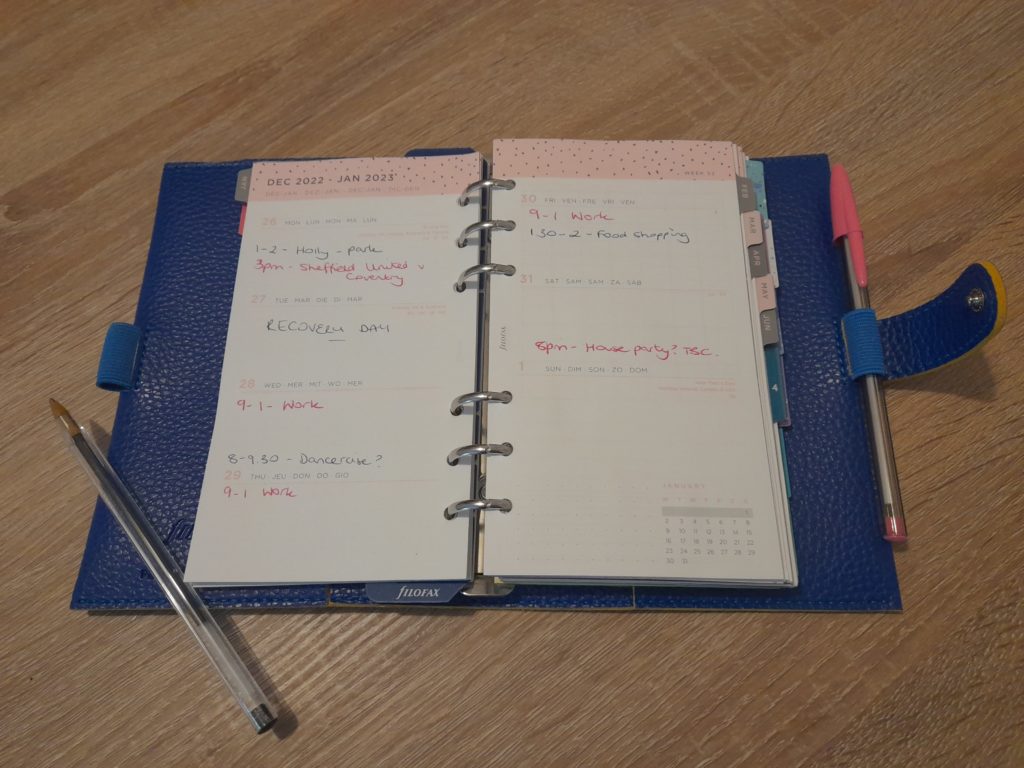Everyone is so busy these days. There are countless demands on our time with work commitments, family life, friendships and general day-to-day tasks needing to be juggled. It’s enough to leave anyone frazzled, but for those with chronic illness, the fast-paced nature of modern life can feel exhausting.
Fatigue first started impacting my life during my mid-twenties. Initially, I put it down to my schedule. I was working full-time in a busy nursery as well as planning my wedding and loving my social life, which revolved around evenings out with friends and weekends watching my beloved Sheffield United Football Club. My symptoms around this time were overwhelming physical and mental fatigue, aching muscles and regular loose bowel movements accompanied by excruciating cramps, but I thought my lifestyle was to blame. As much as I loved the idea of relaxing, it wasn’t in my nature to spend time doing nothing, so I ploughed on. When I visited my doctor for a routine check, she ran tests and said it was most likely IBS.
Over time, my life changed considerably. As a married woman with a child, my once active social life took a back seat and although there were plenty of late nights, it was usually due to my son struggling to settle rather than a wild night out! I reduced my hours at work to enjoy motherhood and put the ongoing fatigue down to the inevitable stresses that came with having a child.
Then my symptoms became worse. Blood was mixed in with the bowel movements — not something that is spoken of in polite society, but vital to discuss. Everything I read suggested this was not normal for IBS, prompting me to return to the doctor’s office. Eventually — and I do mean eventually, as the process took 10 years in total — a colonoscopy confirmed I had Crohn’s Disease.
It took a while to find the best medication to manage the inflammation in my bowel, but adalimumab (often known by the brand names of Humira or Amgevita) brought me into medical remission. On paper it sounded great — remission! Surely that meant waving goodbye to the symptoms that had been negatively impacting my life for so long? Sadly not. The muscle and joint pain were much improved, and the number of bowel movements reduced, but the fatigue was as debilitating as ever.
Related: Managing Lupus Symptoms: Fatigue
I was upset. I was angry. Even armed with a diagnosis and wonder-meds, it was apparent I couldn’t carry on living life at the pace I was accustomed to. Something was going to have to change, but I resented the thought I’d need to give up the things I enjoyed, and I certainly didn’t want to miss the fun of having a young child.
This realisation led to me taking the organizational skills I used at work and applying them to my life. To-do lists had long been the way I kept on top of what needed doing at nursery, making a heavy workload less intimidating by breaking it down into small, manageable chunks. Planners and wallcharts had been my lifesavers many times, so it made sense to utilise these strategies.
My days are now mapped out in a Filofax, with everything that needs doing assigned a timeslot. Walking the dog, washing my hair, booking the food shop delivery slot… these are all in the diary section in blocks of 30 minutes (some of these tasks take more than 30 minutes so take up two, three or more blocks). I prioritise events by color-coding — things that must be done at a specific time (e.g., work or a pre-booked theatre trip) are written in pink, everything else is in black. On the days when I’m not feeling well, I only aim to complete the pink tasks and roll the black tasks over to another day. Then there are the days where doing anything is impossible, when the only option is to curl up with a blanket and recuperate. Sometimes, listening to your body is all you can do. If I know I have a run of pink tasks, I try to block out recovery days in between. On these days I do as much or as little as I feel like — if I’m feeling good, I might do a dancercise class. Other days I won’t move from the sofa.

This next-level planning coined my nickname “Queen of Lists” and, although spontaneity has become a thing of the past, I am able to manage my time (and my “spoons”) much more effectively through strict organization. Of course, as with any chronic illness, Crohn’s has spoilt the party on many occasions. I’ve missed events I’ve desperately wanted to attend and had full days in bed because even rolling from the left side of my body to the right has been agony, but having a schedule has helped, partly because it’s made me assess what is important.
I’m not going to lie — there have been times where I’ve deviated from my planned schedule, like when I went to see One Direction in concert three nights in a row. Or when, on day 13 of a two week holiday to the U.S., the dream day trip to Disneyland nearly broke me. That was worth it, though. I paid the price for a week after but living in the U.K. means the opportunity to visit Mickey and co. doesn’t come around that often.
Related: I Tried Salt Cave Therapy for Lupus Fatigue… Here’s What Happened
Adopting a strict planning strategy might not work as effectively for you as it does for me and it’s not the answer to all problems. You won’t suddenly be full of energy all day every day, and you will still have to cancel plans at the last minute from time to time. However, with realistic goals and prioritising, you may be surprised at how much you can do.
How to Use Planning to Help Your Fatigue
- Choose a place to record your plans. I use a Filofax, but you could just as easily use a
notepad or diary. If you find typing easier than writing, check out online calendars that you
can use on a laptop, tablet or phone. I have a week-to-view planner where I fill in the most
time-consuming tasks and a daily “to-do” list that covers everything, but it is up to you how
much detail you want to go into. The planner may be enough to take the pressure off and
help you feel in control of your commitments. - Decide on a color code. I keep it simple with two colours — pink for priorities and black for best
laid plans — but you might add in other colours depending on your commitments and
lifestyle. - Fill in your priorities first. Be realistic about what these are and remember they are personal
to you and might change over time. If you prioritised seeing your sister last week, it is
perfectly fine to prioritise a trip to see Top Gun: Maverick this week instead. - This is the key step — recovery days! If you notice a run of priorities that have the potential
to wipe you out, add in a recovery day. This doesn’t necessarily mean you have to have a day
of resting, but it gives you the option to do so guilt-free if you’re fatigued.
Katey Lovell is an author of romantic fiction and freelance writer. After being diagnosed with Crohn’s Disease in 2014, she became committed to using time management strategies to enable her to live the life she wanted. Katey lives in Sheffield, UK, with her husband, son and beloved animals — Reggie the doxiepoo and a sassy grey cat called Leia. You can find her on Twitter @Katey_Lovell.

Be the first to comment